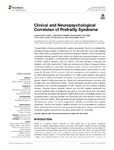Clinical and neuropsychological correlates of prefrailty syndrome

Ver/Abrir
Use este enlace para citar
http://hdl.handle.net/2183/26932
Excepto si se señala otra cosa, la licencia del ítem se describe como Creative Commons Attribution 4.0 International License (CC-BY 4.0)
Colecciones
- Investigación (FCS) [1293]
Metadatos
Mostrar el registro completo del ítemTítulo
Clinical and neuropsychological correlates of prefrailty syndromeAutor(es)
Fecha
2020-11-09Cita bibliográfica
Lorenzo-López L, Blanco-Fandiño J, Cibeira N, Buján A, López-López R, Maseda A, Millán-Calenti JC. Clinical and neuropsychological correlates of prefrailty syndrome. Front Med (Lausanne). 2020 Nov 9;7:609359.
Resumen
[Abstract]
Physical frailty is closely associated with cognitive impairment. We aim to investigate the
neuropsychological profiles of prefrail and non-frail dementia-free community-dwelling
older adults using a comprehensive neuropsychological evaluation, and to examine the
association between specific frailty criteria and clinical and neuropsychological scores.
Participants completed a comprehensive standardized neuropsychological evaluation
(covering cognitive domains such as memory, executive functions, language and
attention), and frailty assessment. Frailty was assessed according to biological criteria:
unintentional weight loss, exhaustion, low physical activity, slowness, and weakness. The
sample comprised 60 dementia-free community-dwelling adults, aged 65 years or older
(range 65–89 years; 60.0% women). Forty-two participants were classified as robust
(no frailty criteria present), and 18 as prefrail (1 or 2 frailty criteria present). We explored
neurocognitive differences between the groups and examined the association between
specific criteria of frailty phenotype and clinical and neuropsychological outcomes with
bivariate tests and multivariate models. Prefrail participants showed poorer cognitive
performance than non-frail participants in both memory and non-memory cognitive
domains. However, delayed episodic memory was the only cognitive subdomain that
remained significant after controlling for age, gender, and educational level. Gait speed
was significantly associated with general cognitive performance, immediatememory, and
processing speed, while grip strength was associated with visual episodic memory and
visuoconstructive abilities. Both gait speed and grip strength were negatively associated
with depressive scores. Our results suggest that prefrailty is associated with cognitive
dysfunction. The fact that specific cognitive domains may be susceptible to subclinical
states of physical frailty may have important clinical implications. Indeed, early detection
of specific cognitive dysfunctions may allow opportunities for reversibility.
Palabras clave
Aging
Prefrailty
Neuropsychologial assessment
Gait speed
Grip strength
Prefrailty
Neuropsychologial assessment
Gait speed
Grip strength
Versión del editor
Derechos
Creative Commons Attribution 4.0 International License (CC-BY 4.0)
ISSN
2296-858X






